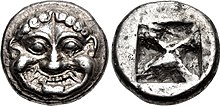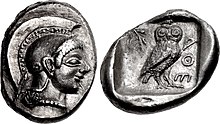
Back النقود المعدنية الإغريقية Arabic Altgriechische Münzen German Αρχαία Ελληνικά νομίσματα Greek Monedas de Grecia Spanish Vanakreeka rahasüsteem Estonian Monnaie grecque antique French Moeda da Antiga Grecia Galician Koin Yunani kuno ID Monetazione greca antica Italian Antike greechische Münze KSH


The history of ancient Greek coinage can be divided (along with most other Greek art forms) into four periods: the Archaic, the Classical, the Hellenistic and the Roman. The Archaic period extends from the introduction of coinage to the Greek world during the 7th century BC until the Persian Wars in about 480 BC. The Classical period then began, and lasted until the conquests of Alexander the Great in about 330 BC, which began the Hellenistic period, extending until the Roman absorption of the Greek world in the 1st century BC. The Greek cities continued to produce their own coins for several more centuries under Roman rule. The coins produced during this period are called Roman provincial coins or Greek Imperial Coins.